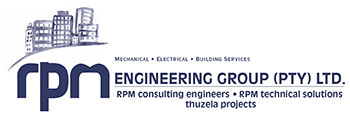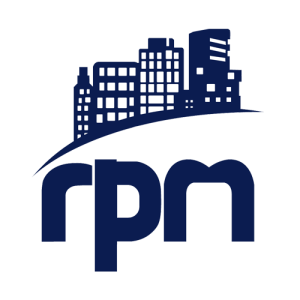By Barry Wallett and Patrick Burke (FSAIRAC), RPM Consulting Engineers, edited by Eamonn Ryan
RPM Consulting Engineers (a division of the RPM Engineering Group) have been appointed to undertake the reinstatement of the HVAC plant serving a 25-storey building in Luanda, Angola.

Modified and installed plantroom.
Following the completion of the site survey, technical specification and detailed scope of work, five local South African HVAC contractors were selected to undertake the project, which includes the following major works:
- Repairs, servicing and remedial work to (18 OFF) air-cooled chilled water generators (chillers)
- New state-of-the-art building management system with optimum energy savings envisaged
- The modification and installation of chilled water pipework and reticulation, associated components and pipe insulation
- The replacement of (272 OFF) FCU controllers, (450 OFF) CHW control valves c/w actuators and (550 OFF) fire dampers
- All associated electrical and control wiring works
- (7 OFF) Chiller screw-compressor replacements (+/-495kW cooling capacity {140TR} each)
- Repairs and service to existing VRF HVAC systems (serving specific IT areas)
- Repairs and major service to all existing CHW fan coil units throughout to include (16 OFF) dedicated tempered fresh air AC units
- New instruments, gauges etc. throughout
- Testing, recommissioning and final handover
- Provide new O&M manuals to include all test and compliance certificates as required
The following selected South African-based contractors have been appointed to implement the specified scope of work. They will be accommodated in Luanda for the duration of the project (16 months) commencing 15 February 2024:
- Ar Azul Projects – major mechanical work and installation
- Infinity Technical Services – BMS, controls and electrical works
- Pictech (Pty) Ltd – chillers; repairs and final commissioning
- Bitzer South Africa – compressors; supply and plantroom installation works
- Skyshot – CIAT equipment; inspections, commissioning and final reports

Another view of the modified installed plantroom.
In addition, full training will be given to the client’s site maintenance staff with regard to the servicing of all plant, BMS controls operation, etc. supported by remote access facilities received from South Africa.
The final objective is to accomplish a further 15–20 years of reliable, maintenance friendly, safe and cost-effective plant operation for the new owners going forward.
RPM MD Barry Wallett says: “As RPM’s largest HVAC refurbishment project to date, we are well aware of the challenges facing us when carrying out work of this nature beyond our borders. Nevertheless, we have selected a highly skilled and experienced contracting team to facilitate the work. As such, we are looking forward to a successful project. In doing so, we furthermore aim to showcase the high standard of South African engineering expertise, commitment and integrity.”
HVAC refurbishment in Luanda, Angola
RPM Consulting Engineers, a division of the RPM Engineering Group, has embarked on its most ambitious project to date: the comprehensive refurbishment of HVAC systems in a landmark 25-storey former bank building located in Luanda, Angola.
Wallett describes how an American-based company approached RPM, after evaluating three leading consulting firms in South Africa. After conducting rigorous site visits and reviewing extensive portfolios, the decision-makers opted to entrust RPM with the task.
Managing a project of this magnitude comes with its challenges, notably logistical complexities and cost considerations. Luanda, known for its high cost of living driven by its oil-centric economy, posed significant hurdles. The client emphasised its preference for managing the project entirely from South Africa, ensuring efficient control over costs and operations amid local economic fluctuations. This strategic decision aligns with its desire for a structured, cost-effective approach overseen by seasoned South African professionals.Newly wired control panel.Existing plantroom 2 – insulation stripped.
Building the expert team
Critical to the project’s success was the first component of the project: assembling a skilled and diverse team. RPM strategically partnered with both local and international entities to ensure comprehensive coverage of technical and logistical requirements. Key collaborators include Portuguese-speaking consultants and contractors, essential for effective communication and cultural liaison in Angola. This approach not only facilitates seamless project execution but also enhances client satisfaction through clear and effective communication channels.
The project involves a multifaceted scope, including the installation of state-of-the-art equipment such as Schneider’s building management system (BMS) and repairs to Emicon chillers, managed in collaboration with Bitzer and suppliers with extensive regional and international experience. RPM’s thorough preliminary surveys identified critical issues, including multiple compressor failures, necessitating proactive solutions to ensure minimal disruption to the fully occupied building.
Wallett anticipates a project duration of 12-18 months, derived from planning and ongoing site assessments, primarily because the original system had been hugely over-designed, says Wallett. Originally constructed for the financial industry, the building has since transitioned ownership. The handover necessitated a shift in occupancy, a process which revealed a history of inadequate maintenance exacerbated by design limitations. RPM’s assessment highlighted deficiencies such as poorly accessible piping and inefficient maintenance pathways, contributing to widespread operational failures across the building’s extensive HVAC infrastructure.
The scale of the project is staggering: encompassing 18 chillers, 16 air handling units, over 500 fan coil units, and a sophisticated Schneider-based BMS. The design, originally commissioned from European consultants, proved challenging to decipher due to incomplete documentation and missing drawings. RPM’s solution involved a methodical approach, integrating design modifications and equipment replacements to achieve functional reliability in what was described as an overly intricate design for the African context.Modified piping in plantroom 7.New pumps.
Client collaboration and project management
Collaboration with the US-based firm managing projects for the client, streamlined communication and project oversight. This partnership ensures seamless coordination between RPM’s technical teams and the building’s tenant.
Logistical planning was the main challenge, particularly navigating Angola’s stringent import regulations. This required meticulous coordination, involving the shipment of equipment and materials in over seven containers from South Africa—a process essential for maintaining project momentum and timeline adherence. Managing cross-border transport of refrigerants would have been excessively complex, prompting RPM to opt for sourcing materials locally to circumvent regulatory constraints.
As the project progresses, RPM anticipates further shipments and logistical manoeuvres to accommodate the extensive scope of work. Approximately six containers have already been dispatched. These include the transportation of essential tools and equipment via air freight. RPM air-freighted initial batches of tools to kickstart the project, followed by a process of sourcing materials from various international suppliers. These materials include piping, insulation, pumps from Germany, and controls from Switzerland, all critical components necessary for the comprehensive refurbishment of the building’s HVAC system.
RPM’s strategy includes segregating hazardous and non- hazardous materials, meticulously documenting each shipment to comply with Angola’s specific requirements.Condenser fan motors installed.Duct insulation.
On-site challenges and adaptive strategies
The operational environment on-site presents its own set of challenges. RPM’s workforce, comprising skilled engineers, technicians and artisans, operates under rigorous conditions, often spending extended periods away from home. Specialised logistical support, including customised meal plans and laundry services, further enhances the team’s efficiency and well-being during their extended stays in Luanda.
Security measures are paramount, given the project’s high-value equipment and materials. RPM has implemented stringent protocols to safeguard against theft while the building’s prominent location on one of Luanda’s main roads requires careful scheduling of deliveries after hours to minimise disruption to traffic.
“One of the foremost challenges we’ve encountered involves the logistics of coordinating multiple shipments. Various components crucial to our project—like Schneider controls from Infinity, spare parts from chiller manufacturers, and materials for contractors—needed to converge seamlessly into one cohesive operation. Despite our efforts to streamline the process into a single consignment across four containers, each invoice had to meticulously detail freight costs, that demanded precise handling,” says Wallett.
Another significant challenge stemmed from inadequate documentation provided at the project’s outset. “Drawings, essential for guiding modifications and installations, proved sorely lacking in detail and accuracy, prompting us to undertake extensive redrafting efforts. Throughout these challenges, intermittent power disruptions further compounded our efforts. While not a common occurrence in Luanda, these disruptions necessitated backup generators—a critical lifeline to maintain momentum in our operations amid ongoing technical and logistical complexities. Looking ahead, our timeline has seen adjustments, with phased occupancy now slated for early this year. We anticipate significant progress once awaited materials arrive, propelling us closer to our milestone of completing the plant rooms and facilitating initial move-ins by year’s end.”
Originally planned as a phased approach with teams alternating, the reality on the ground has necessitated a different strategy. Both initial and subsequent teams have found themselves on site longer than anticipated, leading to a coordinated effort to manage rotations effectively. While some team members are eager to return home after extended stays since February, others must remain to maintain project continuity.
“Once containers arrive, the pace of our work accelerates dramatically, allowing various teams—such as chiller specialists and electrical experts—to swiftly execute their tasks.
“The building’s future success hinges not only on its refurbishment but also on the local team’s ability to maintain these sophisticated systems in the future. Part of our commitment involves imparting essential maintenance knowledge to local technicians. The lack of foundational maintenance practices observed during our initial assessments highlighted the critical need for training. Basic tasks such as monitoring equipment and addressing early warning signs were often overlooked within the previous system. While remote monitoring can handle certain aspects, such as control systems, the hands-on maintenance required for optimal performance necessitates local expertise.”
“Therefore, we’re working towards training local technicians to assume maintenance responsibilities post-project completion,” says Wallet.




